The ability to see in third dimension is fairly near the top of the list of requirements for the animator, assistant animator, and the inbetweener. Most of us come by this knowledge only after years of observation and practice. Some years ago, a simple little drawing book was given to me by its author, Bruce McIntyre. He had devised a sort of shorthand art course that he taught to young children and the results were amazing. His whole premise was built on six rules of perspective and an involved use of directional symbols.
The perspective rules are simply this:
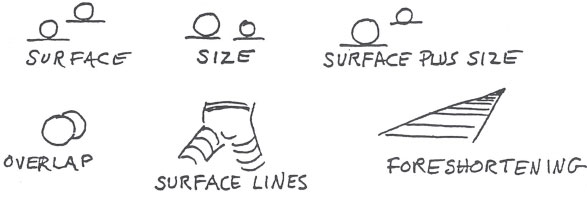
The first two rules, I think, are a preparation for the third one — surface plus size, a rule that is very usable in animation. For instance when working on a scene with a layout like this:
![]()
A character standing on that plane would have two feet fitted to that surface, creating not only a stable stance but also a third dimensional.

Any props such as apples, cans, bowls, etc., as seen below.

The overlap rule is very important to all phases of drawing, especially when the illusion of third dimension is desirable.
Here is an outlandishly simple example where the whole head area is in front of the shoulders and in the next drawing there is a complete reversal. In the first drawing, note how definite the overlap is depicted: the fingers in front of the jaw, the thumb behind and the left thumb in front of the elbow, the fingers behind. Being definite with overlap helps the drawing “read” clearly.
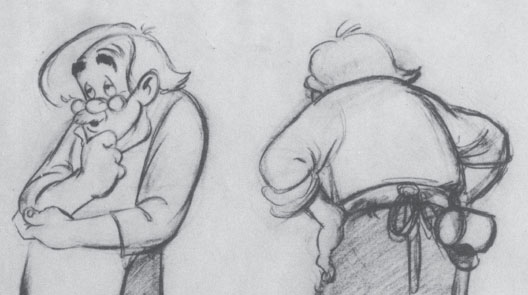
One of the worst traps that catch us unawares is when overlap and tangent gang up on us. A simple example is two mountain shapes drawn with no overlap that automatically creates a tangent and destroys any illusion of depth whatsoever:
![]()
The-simple solution to this problem is to add overlap
![]()
making it very clear which hill is in front of the other. Then if you force the perspective by adding surface plus size to the drawing it will be more definite and read much faster.
![]()
The importance and usefulness of the surface lines rule can only be hinted at. In a rendered drawing or painting, the artist has untold nuances of color, shading, and rendering to emphasize the depth — the animator has only line. Plus, of course the rules of perspective. As for surface lines, there are usually very few in a line drawing. When using a cigar with its surface lines (the band) the importance of using them for direction and depth can easily be seen:

There are few areas on cartoon bodies that can be used like the cigar band. If none at all, the two objects would look like each other only one smaller than the other.

So the artist must use whatever suggests itself. A sleeve for instance

or a pant cuff

or a belt, collar, hemline, pattern on the material, or wrinkles in cloth:

In the case of heads, the basic structure has to serve as a surface line. For instance, the eye, nose, and mouth lines are unseen but implied and depicted by the placement of the eyes and mouth and the direction they take when the head is tilted:

Along with these “unseen” surface lines, there is overlap such as (in this case) the hair, first being seen somewhat behind the forehead then reversing to be in front of the forehead in the second drawing. The ear employs another rule: foreshortening. The other rules such as surface plus size and perspective would have come into play had the head turned to the side:
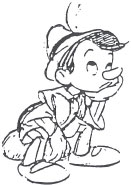
Although the other ear is not seen so it cannot be compared with the one that is seen, it will have grown in size as the head turns the ear toward you and closer to you, thereby giving even a better illusion of depth in motion than you would get from seeing a still drawing or the two ears:
![]()
That increase in size plus a change in shape (angle) plus following an arc (as if the ear were orbiting the outside of a sphere like the head would give a maximum third dimensional effect).
The last rule of perspective is foreshortening, which is none other than Italian perspective in a simplified form. It is used extensively in animation by simply drawing things larger in the foreground than those of like size in the background. For instance, on a head “forced perspective” is used in drawing the eyes, eyebrows, etc.
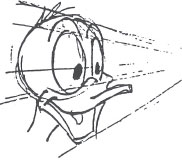
It is the kind of perspective you would get when using a wide-angle lens on a camera. The difference is that the photograph appears distorted and unreal. In the cartoon it is acceptable, partly because we can adjust the whole drawing and make it plausible. It is defying reality but in a logical way. Using logic in animation is a powerful tool. That is how we can use such extreme action and pull it off as believable.
Tangents are the enemy of the illusion of depth and to be avoided at all cost. Tangents occur when two or more lines converge
![]()
or when one line ends at some point then seems to continue on at another point.

Here is an obvious instance of tangent trouble and a simple solution wherein a great deal of depth and clarity is achieved.
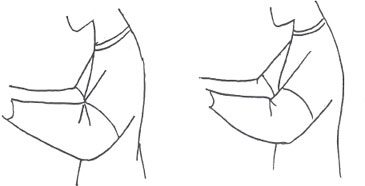
If you can arrange it so all of the rules of perspective are used in one drawing, you will have the maximum third dimension possible in a line drawing.
The directional symbols mentioned above were simple arrows pointing in a number of directions. Each arrow and its direction had a code number. Their use was related to the manner in which Bruce taught drawing. I had never involved myself with his use of directional symbols, but the principle of it completely captivated me. It has influenced every drawing and painting I’ve made since. This principle has made me conscious of the fact that everything is pointing in some direction: pointing away from us, or sideways to us, or three-quarters up at a certain angle, straight at us or slightly to the left or right or down. Most often these directional lines coincide with perspective lines and have a common vanishing point. In the case of drawing a figure, the line directions are not random but have to do with the pose or action. To be conscious of the direction that arms and legs and fingers, etc., are pointing is the key to the third dimensional drawing. It is the thing that reveals to us the six rules of perspective; for instance, if in drawing the legs of a character you find one pointing toward you and the other pointing away:

You know that the surface lines will be dictated by those directions and also surface plus size will influence the placement and size of the feet, and overlap will be necessary to show the right leg is in front of the left leg. Foreshortening will be subtle but the left leg will diminish in size as it recedes from hip to ankle:

Difficult foreshortening in a pose can be more easily handled if one is aware of which direction the object is pointing; for instance, if there is a figure bending over toward you, which is a difficult view. The problem can best be conquered by the awareness of what is happening. To you it looks like this:

From the side it would be a much more drawable view.

However, merely being aware of the side view will help you pick the rules of perspective that are needed to conquer this foreshortening dilemma.

The surface lines of the chest and stomach will be almost circular; the arms, held slightly back will have a less circular surface line; and one leg forward and one back will require opposite surface lines. The leg on the right would diminish slightly in size as it goes away from you while the other increases, employing the foreshortening rule. The head in front of the chest applies the overlap rule, while the rule of surface plus size is employed in the feet. True, these things (rules) are present all around us, so, so what? The what is being aware of them as a positive aid in drawing, allowing you to progress directly to the pose, rather than rely on a lot of doodling, pencil manipulation, and haphazard accidentals.
If you wanted to play Mozart music on the piano, you would not doodle on the piano hoping some day to come across something that sounded like Mozart. No, first you would study the rules — the rudiments of music — and then with a little practice you could bring Mozart to life. Drawing is no different.
There is another approach to drawing the figure that may seem a bit bizarre at first, but is worth your consideration. It is especially helpful when working out a difficult foreshortening problem. This method merely employs pipes as parts of the body.
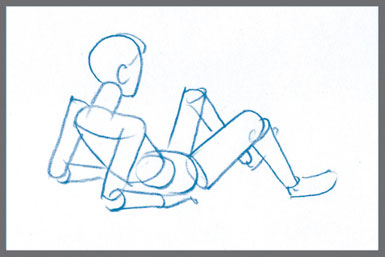
This system will also help with all of the other rules such as surface lines, surface plus size, and overlap.
